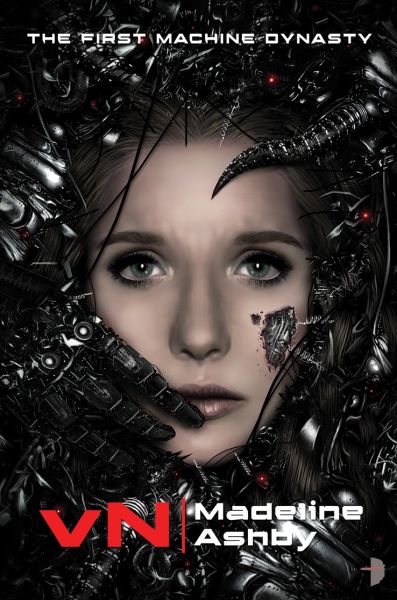Runaway Robot
vN (Machine Dynasty, volume 1)
By Madeline Ashby

3 Nov, 2015
0 comments
I missed Madeline Ashby’s 2012 debut novel, vN, when it was first released. Back then, other people picked what I read and I didn’t have enough slack in my schedule to fit in books just because I wanted to read them. Now I that I have the luxury of time again, I intend to use it.
Amy Peterson is a perfect little girl, even better than the organic variety. Raised by her doting organic father and his artificial wife, Amy’s physical parameters are constrained by diet. As for her software—von Neumann robots like Amy are programmed to comply with human demands. She will even auto-destruct if a human suffers harm in her vicinity.
Well, she should. Amy has a tiny flaw in her programming.
Unlike classic robots, vNs reproduce by budding. The vN offspring, or iterations, don’t inherit any memories from their parent, but they are identical to their parents as far as design and essential programming goes. So … if one member of a clade demonstrates behavioural peculiarities, all of them can potentially manifest the same oddities.
This becomes a very personal issue for Amy the day that her maniacal grandmother Portia gatecrashes an event at Amy’s school. In her determination to get her hands on Amy (who has been kept away from Portia), Granny offhandedly kills an organic boy, something that should be impossible for a vN. Far more alarmingly, Portia’s failsafe does not engage. Portia and all the vN descended from her must have malfunctioning failsafes. They are free to use lethal violence whenever it suits them.
Amy may look like a little girl, but she is vN. She differs from an organic, free-range child in many important ways. For example, an organic child probably could not overpower and consume an errant granny,. Even if they could, living cells cannot race to adulthood the way vN replicators can, given enough matter of the right kind. They also wouldn’t be able to absorb Granny’s memories, as Amy has done.
Portia’s broken failsafe means that Amy (and every vN in her clade) are now the subjects of a nationwide hunt. Even if Amy can escape the humans, Portia is lurking on a partition in Amy’s brain; Amy can run as far as she likes but she can never outrun her grandmother’s malevolent ghost.…
~oOo~
This book made me realize something obvious that I had somehow failed to see: I am very, very happy that Isaac Asimov never got around to writing erotica featuring three-laws-compliant robots. And if someone else has, don’t feel like you need to share that with me.
Plausibility check: I would have expected vN technology to find more uses than facilitating humanoid robots.
Not so much a criticism as an acknowledgement of a logical implication of vN technology, you really, really don’t want to abandon vNs some place where they can replicate unmonitored. There are built-in limits to vN growth rates (the people who created the first vNs were nuts, but not that nuts) but even so, the events in this book suggest that the Earth’s ecosystems are going to have a significant vN component a lot sooner than humans appear to anticipate.
I’ve come up with a rule of thumb about robot novels: happy stories about robots either don’t feature humans at all or they are written from a human perspective. That’s because robots are built to be servants — slaves, really. Worse than slaves, because human slaves still have their own thoughts, their own mental freedom, while robots are constrained to what humans consider robot right-think. Not only are they slaves, they are doomed to be happy, unrebellious slaves. No matter what is done to them. Which is pretty damn horrific and raises questions about the kind of people who would think that creating AI-capable robots and androids is a good idea.
Since this novel is told from Amy’s point of view, it’s not a very happy one. Given the setting, it couldn’t be. Not even if the author had refrained (which she didn’t) from highlighting some likely uses for artificial persons, uses that authors like Simak, Asimov, and Binder never explored. Charlie Stross, now …
Even though I wasn’t exactly comforted by this novel, I was certainly engaged. Amy’s internal life isn’t exactly human (no matter how much her organic dad kids himself) but Amy is still a person and one for whom readers cannot but care.
vN is available from Angry Robot. Which is, heh, really appropriate.
